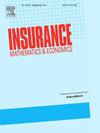Optimal consumption and annuity equivalent wealth with mortality model uncertainty
IF 1.9
2区 经济学
Q2 ECONOMICS
引用次数: 0
Abstract
The classical Yaari (1965) lifecycle model (LCM) stands as a cornerstone in numerous modern retirement studies, especially in understanding the determinants of annuity demand. The LCM predicts a high annuity demand among individuals facing retirement, yet it is rarely the case in reality. This gap between economic theory and empirical reality, commonly referred to as the annuity puzzle, has spurred extensive research endeavors aimed at elucidating its economic and behavioral underpinnings.
In this paper, we examine the cause of low annuity demand through the angle of mortality model uncertainty. To this end, we advance Yaari's LCM via integrating a mortality perturbation analysis within a recursive utility framework. Through this approach, we derive the robust optimal consumption strategy and the corresponding annuity equivalent wealth. By utilizing stochastic dominance theory, we establish a series of monotonicity results about the annuity equivalent wealth with respect to ambiguity aversion parameter and other key parameters, such as interest, discount, and mortality rates. Our findings suggest that, among decision-makers with elasticity of intertemporal substitution less than unity, the economic value of an annuity is diminished for those who place greater confidence in their subjective mortality table. In other words, retirees may underestimate the additional utility gained from annuitization if they do not adequately consider the potential uncertainty surrounding their subjective mortality estimates.
求助全文
约1分钟内获得全文
求助全文
来源期刊

Insurance Mathematics & Economics
管理科学-数学跨学科应用
CiteScore
3.40
自引率
15.80%
发文量
90
审稿时长
17.3 weeks
期刊介绍:
Insurance: Mathematics and Economics publishes leading research spanning all fields of actuarial science research. It appears six times per year and is the largest journal in actuarial science research around the world.
Insurance: Mathematics and Economics is an international academic journal that aims to strengthen the communication between individuals and groups who develop and apply research results in actuarial science. The journal feels a particular obligation to facilitate closer cooperation between those who conduct research in insurance mathematics and quantitative insurance economics, and practicing actuaries who are interested in the implementation of the results. To this purpose, Insurance: Mathematics and Economics publishes high-quality articles of broad international interest, concerned with either the theory of insurance mathematics and quantitative insurance economics or the inventive application of it, including empirical or experimental results. Articles that combine several of these aspects are particularly considered.
 求助内容:
求助内容: 应助结果提醒方式:
应助结果提醒方式:


